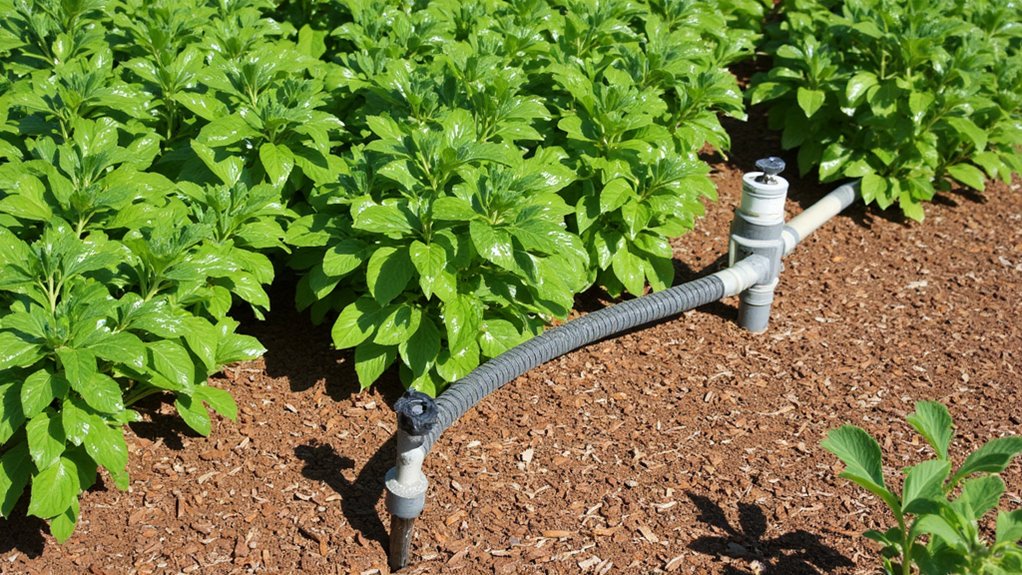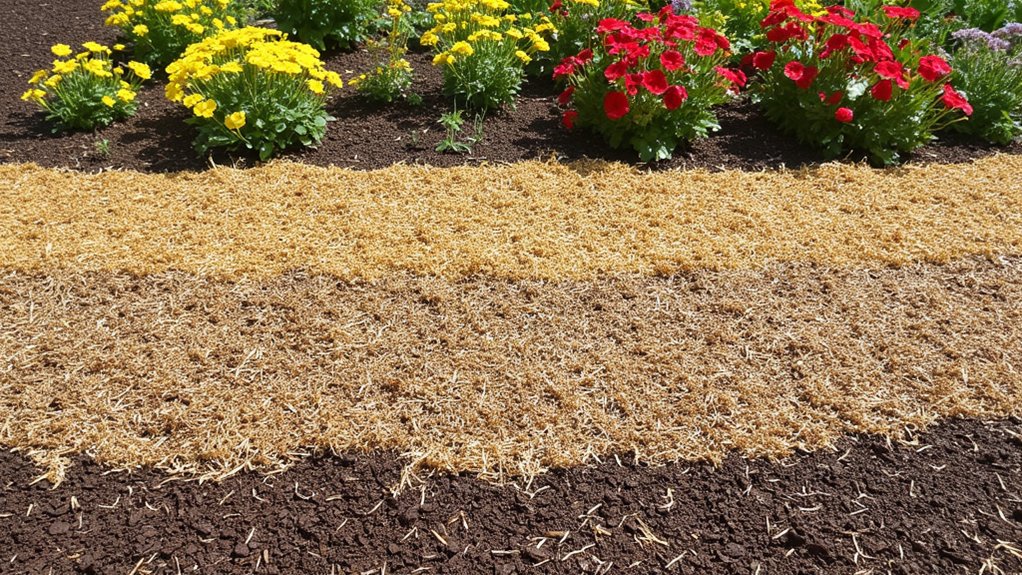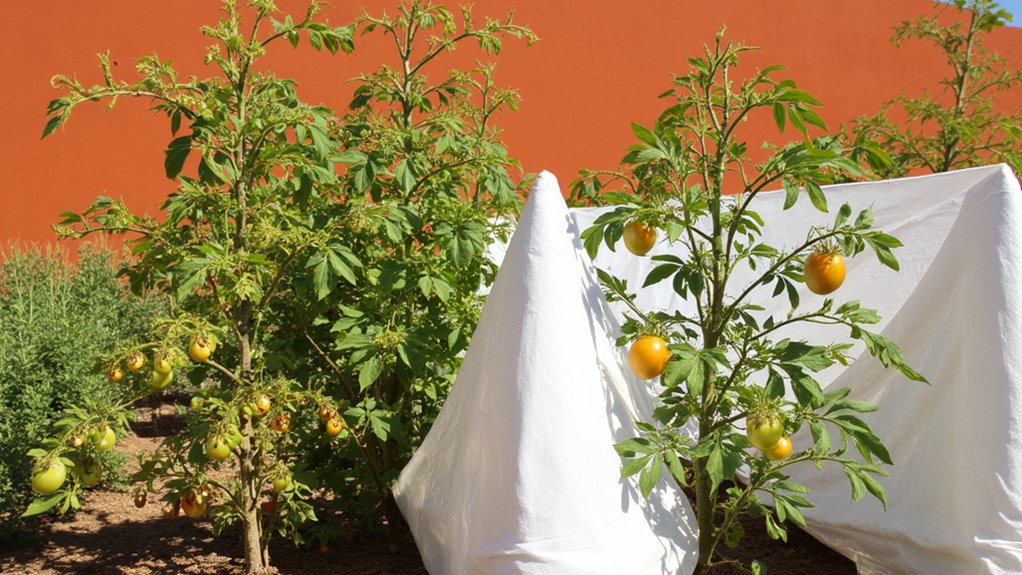While keeping plants thriving during summer isn’t rocket science, you’ll need more than just regular watering to protect them from heat stress. You’re probably familiar with basic plant care, but summer’s intense conditions demand specific strategies to maintain healthy growth. From precise watering schedules and mulching techniques to smart placement adjustments, these proven methods will transform how you approach warm-weather plant care and help your garden flourish even on the hottest days.
Contents
- 1 Smart Watering Strategies for Hot Weather
- 2 Finding the Perfect Summer Location for Your Plants
- 3 Mulching Techniques to Lock in Moisture
- 4 Managing Humidity Levels Like a Pro
- 5 Signs of Heat Stress and Quick Solutions
- 6 Pruning and Maintenance During Peak Heat
- 7 Essential Summer Fertilizing Tips
- 8 Creating Shade Solutions for Sun Protection
- 9 Best Times for Transplanting and Repotting
- 10 Pest Prevention in Warmer Weather
Smart Watering Strategies for Hot Weather

While summer’s intense heat can quickly dehydrate your plants, implementing the right watering routine makes all the difference. Water deeply in the early morning, between 5 and 7 AM, when evaporation rates are lowest and roots can absorb moisture efficiently.
Don’t sprinkle lightly each day – instead, give your plants a thorough soaking 2-3 times per week, allowing water to penetrate 6-8 inches deep. You’ll know it’s enough when the soil feels moist but not waterlogged when you insert your finger.
For container plants, water until you see it flowing from drainage holes, and consider using self-watering devices during heat waves.
Finding the Perfect Summer Location for Your Plants
Beyond proper watering, your plants’ location can make or break their summer survival. During intense heat, you’ll need to assess each plant’s light requirements and adjust their placement accordingly.
For sun-loving plants, guarantee they’re getting morning light rather than harsh afternoon rays, especially between 2-4 PM. Move sensitive plants 3-4 feet away from windows, or add sheer curtains to filter intense sunlight.
Create humidity zones by clustering plants together on pebble trays filled with water. Keep plants at least 6 inches away from air conditioning vents, as cold drafts can shock their systems and cause leaf drop.
Mulching Techniques to Lock in Moisture

Since summer heat can quickly dry out soil, proper mulching becomes your secret weapon for moisture retention. Apply a 2-3 inch layer of organic mulch, like shredded bark or straw, around your plants while leaving a 2-inch gap near the stems to prevent rot.
For ideal results, you’ll want to lay down mulch when the soil is already moist, typically after a thorough watering or rainfall. Don’t forget to refresh your mulch every 4-6 weeks, as it naturally breaks down over time.
Pine needles work especially well for acid-loving plants, while cocoa hulls provide both moisture retention and a pleasant chocolate scent that’ll make your garden uniquely appealing.
Managing Humidity Levels Like a Pro
Proper mulching helps control soil moisture, but the air around your plants needs attention too. During summer’s heat, you’ll want to maintain humidity levels between 40-60% for most indoor plants, while tropical varieties prefer 60-80%.
You can increase humidity by grouping plants together, creating a pebble tray filled with water, or running a humidifier nearby. For outdoor plants, mist them early in the morning, allowing leaves to dry before nightfall.
Monitor humidity with a digital hygrometer, and adjust your routine accordingly. If you notice brown leaf tips or wilting despite adequate watering, low humidity is likely the culprit.
Signs of Heat Stress and Quick Solutions

When temperatures climb above 85°F (29°C), your plants will show telltale signs of heat stress that you can’t ignore. Watch for wilting leaves, even in moist soil, brown leaf edges, and yellowing foliage. You’ll also notice stunted growth and dropped flowers or fruits.
To rescue heat-stressed plants, move containers to shaded areas immediately. For garden plants, install temporary shade cloth 6-12 inches above the canopy. Water deeply at the root zone, preferably in the early morning, and mist the leaves to cool them down. If you spot crispy leaves, trim them off to redirect your plant’s energy to healthy growth.
Pruning and Maintenance During Peak Heat
Although summer heat creates challenging conditions for pruning, you’ll still need to maintain your plants during these warm months. Plan your pruning sessions for early morning, before 9 AM, when temperatures are coolest and plants are less stressed.
Remove dead or diseased branches with clean, sharp pruners, making 45-degree cuts 1/4 inch above leaf nodes. Don’t remove more than 20% of healthy growth during summer, as this can weaken the plant. Focus on maintaining shape and removing crossing branches.
After pruning, water deeply at the root zone and apply a 2-inch layer of mulch to retain moisture. Keep pruned plants in partial shade for 48 hours while they recover.
Essential Summer Fertilizing Tips
Summer fertilizing requires careful timing and the right nutrients to avoid stressing heat-sensitive plants. You’ll want to feed your plants early in the morning, before temperatures climb above 85°F, using a balanced 10-10-10 fertilizer diluted to half strength.
For flowering plants, switch to a phosphorus-rich formula (5-10-5) every two weeks, while leafy plants need nitrogen-heavy feeds (10-5-5) monthly. Don’t fertilize drought-stressed plants, and always water thoroughly before applying nutrients.
Remember to reduce fertilizing by 50% during extreme heat waves, and stop feeding entirely two months before your first frost date to prevent tender new growth.
Creating Shade Solutions for Sun Protection
Since intense sunlight can scorch your plants’ delicate leaves, you’ll need to create strategic shade solutions throughout your garden. Install shade cloth with 30-50% light penetration, positioning it 12-18 inches above your plants to allow proper airflow. For smaller areas, try portable umbrellas or DIY shade frames using PVC pipes.
Natural shade options work well too. Place taller plants like sunflowers or climbing vines on trellises to protect shorter, shade-loving specimens. You can also utilize existing structures – fences, walls, or trees – by positioning vulnerable plants on their north or east sides during peak afternoon heat.
Best Times for Transplanting and Repotting
The early morning hours between 6-9 AM provide ideal conditions for transplanting and repotting during summer months. Your plants aren’t stressed from heat yet, and the soil’s still cool enough to minimize root shock.
You’ll want to prep your new containers 24 hours before transplanting, filling them with pre-moistened potting mix. When you’re ready to transplant, gently squeeze the pot’s sides to loosen the root ball, then lift the plant while supporting its base.
After transplanting, water thoroughly and keep your newly potted plants in a shaded spot for 3-5 days. Don’t fertilize until you see new growth, usually within 2 weeks.
Pest Prevention in Warmer Weather
While your newly repotted plants adjust to their homes, you’ll want to stay alert for unwanted garden visitors. Summer’s warmth brings out pests like aphids, spider mites, and whiteflies, which can quickly multiply in humid conditions.
Check your plants’ leaves every 3-4 days, paying special attention to the undersides where insects often hide. You can prevent infestations by spraying neem oil solution (2 tablespoons per gallon of water) every two weeks.
Place yellow sticky traps 6 inches above your plants to catch flying pests, and maintain proper air circulation with fans or 12-inch spacing between containers to discourage fungal growth and pest activity.
